Fluke - Study guides, Class notes & Summaries
Looking for the best study guides, study notes and summaries about Fluke? On this page you'll find 198 study documents about Fluke.
Popular textbooks 'Fluke'
All 198 results
Sort by
 Popular
Popular
-
MISSOURI BOATING LICENSE EXAM | QUESTIONS & ANSWERS (VERIFIED) | LATEST UPDATE | GRADED A+
- Exam (elaborations) • 66 pages • 2024
-
- $14.99
- 1x sold
- + learn more
1 MISSOURI BOATING LICENSE EXAM | QUESTIONS & ANSWERS (VERIFIED) | LATEST UPDATE | GRADED A+ Bow Correct Answer: Front of the vessel. Stern Correct Answer: Rear of the vessel. Starboard Correct Answer: Right side of the vessel. Port Correct Answer: Left side of the vessel. Hull Correct Answer: Body of the vessel. Gunwale Correct Answer: Upper edge of vessel's side. 2 Cleat Correct Answer: Metal fitting on which a rope can be fastened. Propeller Correct Answer: Rotates and ...
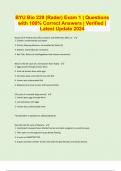 Popular
Popular
-
BYU Bio 220 (Rader) Exam 1 | Questions with 100% Correct Answers | Verified | Latest Update 2024
- Exam (elaborations) • 7 pages • 2023 Popular
-
- $10.49
- 1x sold
- + learn more
Name the 4 Protista that affect humans and HOW they affect us - 1. Giardia- contaminated cold water 2. African Sleeping Sickness- transmitted by Tsetse fly 3. Malaria- transmitted by mosquitos 4. Red Tide- Bloom of dinoflagellates that release neurotoxins What is the life cycle of a trematode? (liver fluke) - 1. Eggs passed through human feces 2. snail eat human feces with eggs 3. Cercariae leave snail and burrow into fish 4. Human eat undercooked fish 5. Metacercaria move to liver a...

-
Test Bank for Evolution, Making Sense Of Life, 2nd Revised Edition by Carl Zimmer, Prof. Douglas Emlen.
- Exam (elaborations) • 163 pages • 2022
-
- $17.99
- 5x sold
- + learn more
Test Bank, Chapter 1 1. Which of the following is NOT an example of evolution? (a) Beak size in a population of birds becomes larger from one generation to the next because larger beaked birds had higher reproductive success and passed the trait to their offspring (b) Over long periods of time whales gradually lost their hindlimbs (c) When traveling to high altitude, human physiology changes to accommodate lower oxygen levels (d) All of the above are examples of evolution 2. The fluke ...
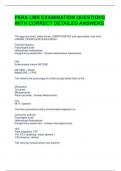
-
PARA LMR EXAMINATION QUESTIONS WITH CORRECT DETAILED ANSWERS
- Exam (elaborations) • 19 pages • 2024
- Available in package deal
-
- $12.49
- + learn more
PARA LMR EXAMINATION QUESTIONS WITH CORRECT DETAILED ANSWERS The eggs are small, yellow-brown, EMBRYONATED and operculated, may have mINIMAL OPERCULAR SHOULDERS: Fasciola hepatica Fasciolopsis buski Heterophyes heterophyes Paragonimus westermani - Answer-Heterophyes heterophyes Hint: Embryonated means MATURE MATURE = SHOC IMMATURE = FFPE The infective life cycle stage of a fluke (except blood fluke) is the: Mircacidum Cercariae Metacercariae Pleurocercariae - Answer...
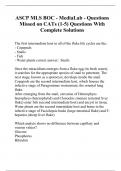
-
ASCP MLS BOC - MediaLab - Questions Missed on CATs (1-5) Questions With Complete Solutions
- Exam (elaborations) • 102 pages • 2023
-
- $17.99
- + learn more
The first intermediate host in all of the fluke life cycles are the: - Copepods - Snails - Fish - Water plants correct answer: Snails Once the miracidium emerges from a fluke egg (in fresh water), it searches for the appropriate species of snail to penetrate. The next stage, known as a sporocyst, develops inside the snail. Copepods are the second intermediate host, which houses the infective stage of Paragonimus westermani, the oriental lung fluke. After emerging from the snail, cercar...
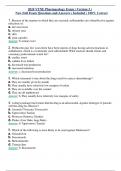
-
2024 VTNE Pharmacology Exam ( Version 3 ) New Full Exam Questions and Answers ( Included ) 100% Correct
- Exam (elaborations) • 35 pages • 2024
- Available in package deal
-
- $12.49
- + learn more
2024 VTNE Pharmacology Exam ( Version 3 ) New Full Exam Questions and Answers ( Included ) 100% Correct 1. Because of the manner in which they are excreted,sulfonamides are ofteneffective against infections of: a. nervous tissue b. urinary tract c. skin d. joint capsules Answer: b. urinary tract 2. Within the past few years there have been reports of dogs having adversereactions to sulfadiazine, which is a commonly used sulfonamide.What reaction should clients and veterinary profe...

-
MIP 260 Diagnostics Exam Questions and Answers All Correct
- Exam (elaborations) • 4 pages • 2024
- Available in package deal
-
- $11.49
- + learn more
MIP 260 Diagnostics Exam Questions and Answers All Correct What group do Schistosoma species belong to? - Answer-Trematode (Fluke) What is the diagnostic stage for Schistosoma Species? - Answer-Egg What is the preferred diagnostic test to identify Schistosoma species? - Answer-Sedimentation What is the preferred diagnostic test to identify flukes? - Answer-Sedimentation What group does Fasciola hepatica belong to? - Answer-Trematode (Fluke) What is the preferred diagnostic t...
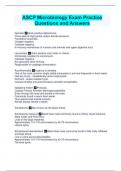
-
ASCP Microbiology Exam Practice Questions and Answers
- Exam (elaborations) • 33 pages • 2024
- Available in package deal
-
- $14.49
- + learn more
Gemella Gram positive diplococcus. Thrive best at high partial carbon dioxide pressure. Facultative anaerobe. Oxidase negative. Catalase negative. In mucous membranes of humans and animals and upper digestive tract. Leuconstoc Gram positive cocci often in chains. Intrinsically resistant to vancomycin. Catalase negative. Are generally slime forming. Responsible for cabbage fermentation. Acanthamoeba A genus of amoeba One of the most common single celled eukaryotes in soil and ...
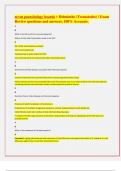
-
acvm parasitology boards > Helminths (Trematodes) / Exam Review questions and answers, 100% Accurate.
- Exam (elaborations) • 8 pages • 2024
- Available in package deal
-
- $10.49
- + learn more
Review questions and answers, 100% Accurate. 1 Q What is the DH and IH for Fascicola hepatica? Where do the adult trematodes reside in the DH? A DH: Cattle and herbivorius animals 1st IH: Lymnaedid snail metacercariae in water plants (2nd IH) Live in the bile ducts of ruminant and other mammalian hosts 2 Q Describe Acute fluke disease associated with Fascicola hepatica A Invasion of the liver from juvenile flukes from recently ingested metacercariae Heavy invasions of the sort ass...
![[PARA-LAB] Trematodes Exam test Rating A+](/docpics/4460335/65c6196ec07f9_4460335_121_171.jpeg)
-
[PARA-LAB] Trematodes Exam test Rating A+
- Exam (elaborations) • 6 pages • 2024
-
- $10.39
- + learn more
Chinese Liver Fluke - ANSWER_Clonorchis sinensis: [CN] Dicrocoelium dendriticum - ANSWER_AKA Fasicola denriticum / Fasciola lanceolata Cionella lubrica - ANSWER_Dicrocoelium dendriticum: [1st IH] Formica fusca / ants - ANSWER_Dicrocoelium dendriticum: [2nd IH] Pancreatic fluke - ANSWER_Eurytrema pancreaticum: [CN] Macrochlamys indica - ANSWER_Eurytrema pancreaticum: [1st IH] Lanceolate Fluke / Lancet Fluke - ANSWER_Dicrocoelium dendriticum: [CN] Giant Intestinal Fluke - ANSW...
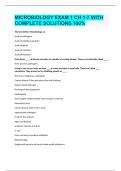
-
MICROBIOLOGY EXAM 1 CH 1-7 WITH COMPLETE SOLUTIONS 100%
- Exam (elaborations) • 22 pages • 2023
- Available in package deal
-
- $13.49
- + learn more
MICROBIOLOGY EXAM 1 CH 1-7 WITH COMPLETE SOLUTIONS 100% The text defines Microbiology as: study of pathogens study of infectious particles study of germs study of microbes study of microbes Only about ____ of known microbes are capable of causing disease. These are technically called _____. three percent, pathogens Living in and on our body we have ___ as many microbes as total cells. These are called ____ microbiota. They protect us by inhibiting growth of ____. Ten times, indigeno...

Study stress? For sellers on Stuvia, these are actually golden times. KA-CHING! Earn from your study resources too and start uploading now. Discover all about earning on Stuvia



